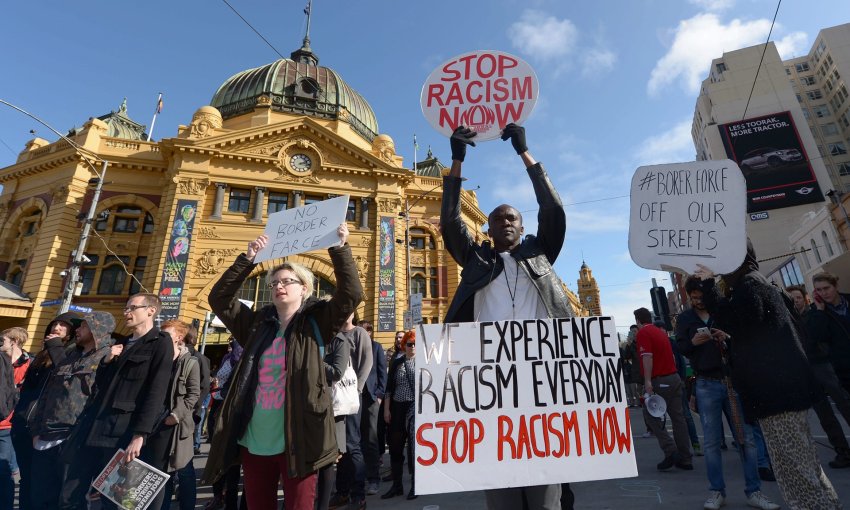
It very quickly became “Border Farce”.
Within hours of the Australian Border Force — Prime Minister Tony Abbott's paramilitary amalgamation of the Customs Service and immigration department — announcing on August 28 that they would be joining the Victorian police and privatised public transport operators in Operation Fortitude to check the visa status of “anti-social” elements on the streets of Melbourne, hundreds of protesters had gathered at Flinders Street Station and social media had exploded in outrage.
An unedifying spectacle of buck-passing followed as the Border Force hierarchy pushed the blame down the chain of command, as did government ministers — except for immigration minister Peter Dutton, who vanished.
Eventually the government, and its tame journalists, settled on the line that the problem was “a poorly-worded media release”.
It was not. And farcical as the events of August 28 were, the real problem is not funny.
As Canadian author and activist Naomi Klein said on the ABC's Q&A on August 31: “It is one thing for people to rise up when it is happening on the streets of Melbourne, but I would like to see people rise up on the streets of Melbourne, streets of Sydney, about what is happening in Nauru.”
When Abbott introduced the Border Force on July 1, many on social media noted that their black uniforms were uncomfortably reminiscent of Nazi Germany. The uniforms were not the only reminder. Provisions in the enabling legislation, the Border Force Act, include virtual immunity for guards at the offshore refugee jails in Nauru and Manus Island who abuse refugees and a two-year jail sentence for whistleblowers reporting abuse.
This came as evidence presented to a Senate inquiry into Nauru showed horrific systematic abuse of adults and children, including torture, sexual exploitation, medical neglect and inadequate food and clothing. The government's response was to declare any future Senate inquiries a “waste of resources” — unlike inquiries into halal food or the non-existent health risks from wind farms.
Abbott’s response to an earlier report by the Human Rights Commission was to launch a vicious smear campaign against Human Rights Commissioner Gillian Triggs.
This follows a well-established pattern. Abbott was elected through a media-supported campaign of vilifying refugees.
Once elected, savage attacks on ordinary people's living standards for the benefit of the corporate elite — through cuts to health, education and welfare and attacks on workers' rights and unions — meant that his government quickly became one of the most unpopular in Australian history.
The government’s attempts to regain popularity have followed two related paths: attacking refugees and beating the “national security” drum.
This is nothing new. The Australian ruling class has always used racism to gain the allegiance of the racially favoured majority of the working class.
The current model of refugee-bashing was created at the turn of the century by the John Howard Liberal government, and dovetailed conveniently with the wave of Islamophobic hysteria about terrorism which swept the Western world after the 2001 al-Qaeda attacks on the US and the US-led wars they triggered.
Since 2001, both Liberal and Labor governments have introduced increasingly brutal persecution of refugees and draconian “anti-terror” laws that are mostly used against Muslim Australians but have the potential to be used against anyone.
Under Abbott, anti-terror laws have reached the point where dual nationals can have their citizenship revoked without any judicial process. The government is working to extend this to Australian citizens without dual nationality.
A total ban on refugees who arrive by boat settling in Australia has been put in place.
The bipartisan nature of refugee-bashing was highlighted in Australian Labor Party leader Bill Shorten’s response to Operation Fortitude — he was initially supportive, then critical of the government’s incompetence, but not its intent.
“Labor obviously believes in targeting crime. I hope that any of these actions are done to try to protect Australian laws, to make sure that people are not overstaying their visas, to make sure that temporary guest workers are not being exploited … If you’re going to do a blitz I don’t know why you’d necessarily telegraph it to the media first,” he said.
The number of refugees arriving in Australia is tiny compared to the numbers arriving in Europe, which is itself tiny compared to the number of refugees in poor countries close to the conflicts and tyrannies they are fleeing.
The purpose of anti-refugee laws is not to respond to a crisis caused by large numbers of refugee arrivals but to create the impression that there is such a crisis hitting Australia. This explains why a government so committed to spending cuts is willing to spend astronomical amounts on persecuting refugees.
It was recently revealed that the government spent $55 million to send four refugees to live in poverty in Cambodia — more than $13 million per refugee. Abusing them in Nauru and Manus Island is not much cheaper.
The government spent $10 million on uniforms, weapons and signage for the new Border Force.
Hopefully, the farce that Operation Fortitude descended into will become a turning point — and make the connection between persecution of refugees and cynical politicking by governments clearly visible.